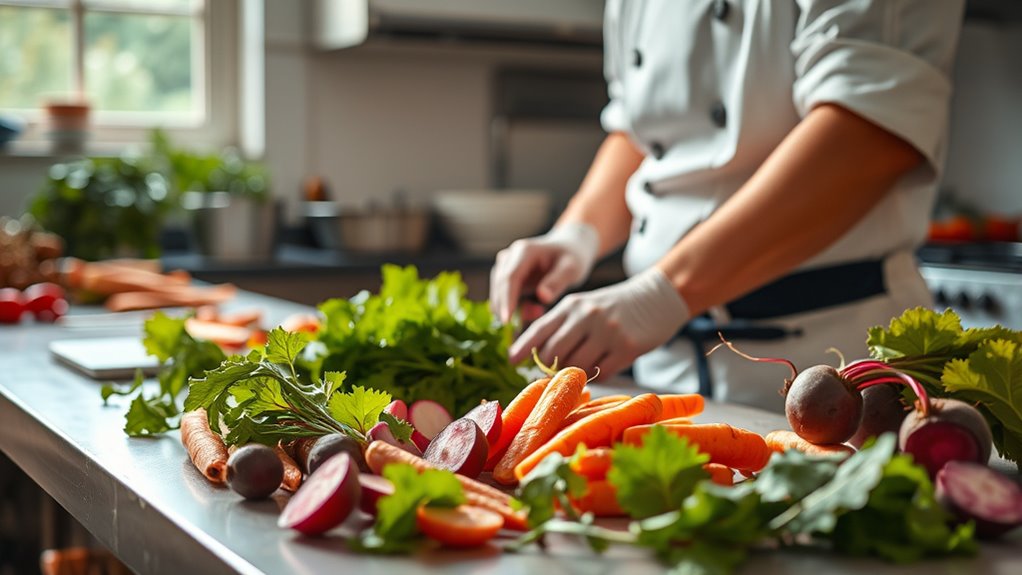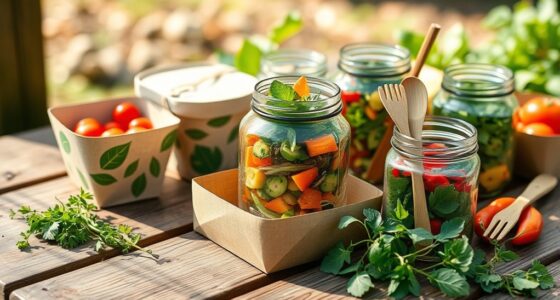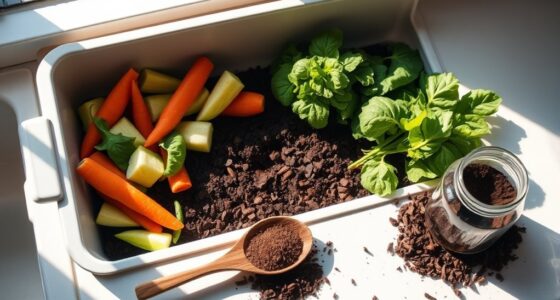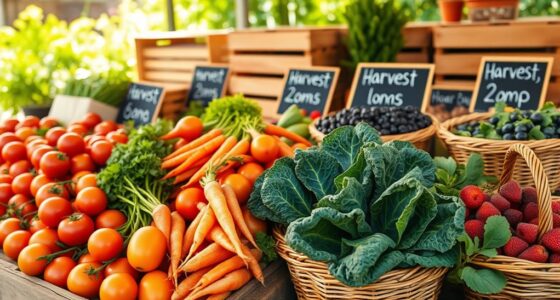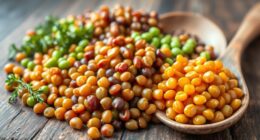Root-to-stem cooking helps you cut down on food waste by using every part of vegetables and roots, like tossing beet greens or carrot tops into your meals. It encourages you to explore edible parts often thrown away, turning scraps into flavorful ingredients. This sustainable approach not only reduces waste but also adds variety and nutrients to your dishes. By adopting these techniques, you can make a positive environmental impact and enjoy more creative cooking—discover more ways to maximize your produce.
Key Takeaways
- Utilize vegetable and root parts like greens, stems, and skins to maximize edible resources and minimize waste.
- Incorporate foraged ingredients from local environments to expand usable plant parts and reduce reliance on store-bought produce.
- Transform kitchen scraps into flavorful components, turning waste into culinary treasures and reducing landfill contributions.
- Practice composting of vegetable scraps to create nutrient-rich soil that supports sustainable gardening and reduces waste.
- Embrace a resourceful cooking approach that promotes sustainability, reduces ecological impact, and encourages mindful use of food parts.
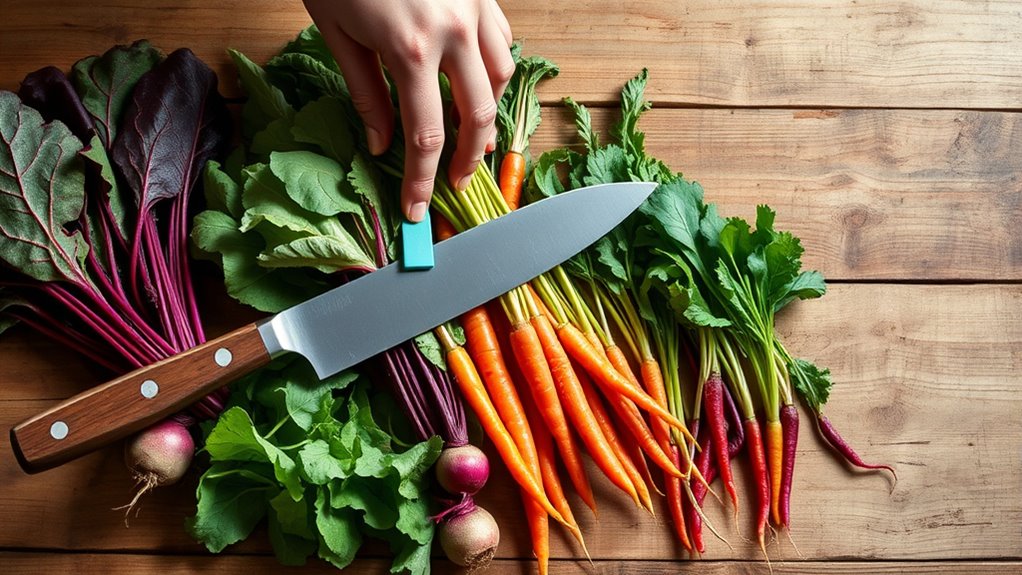
Root-to-stem cooking is a sustainable approach that encourages you to use every part of vegetables and roots, minimizing waste and maximizing flavor. This method not only helps reduce your environmental impact but also unlocks new layers of taste in your meals. To get started, you need to familiarize yourself with foraging techniques, which involve identifying edible plant parts in your local environment. Foraging can supplement your kitchen scraps by sourcing herbs, greens, and roots from nearby parks, gardens, or wild areas. When foraging, always ensure you correctly identify plants and avoid anything sprayed with chemicals. Once you’ve gathered your ingredients, you can incorporate various parts of vegetables and roots into your cooking, such as beet greens, carrot tops, broccoli stems, and potato skins. These often-overlooked parts are rich in nutrients and flavor, transforming ordinary dishes into culinary treasures.
Embrace root-to-stem cooking by using every part of vegetables and roots to reduce waste and enhance flavor.
In addition to foraging, practicing kitchen composting plays a pivotal role in reducing waste. Composting your vegetable scraps turns what would be trash into valuable soil amendment, creating a closed-loop system that benefits your garden or plants. You can set up a simple compost bin in your backyard or use community composting programs if space is limited. When composting, be mindful to include kitchen scraps like vegetable peels, stems, and leaves, while avoiding meat or dairy to prevent odors and pests. Composting not only diverts waste from landfills but also enriches your soil, making your garden more productive. This sustainable practice complements root-to-stem cooking by guaranteeing that even unavoidable scraps are reused in an eco-friendly way. Additionally, utilizing nutrient-rich plant parts can boost the health and flavor of your dishes.
Adopting foraging techniques and kitchen composting together encourages you to rethink food waste. Instead of discarding vegetable trimmings or roots, you learn to see potential in every part of your produce. For example, carrot tops can be turned into pesto or added to soups, while broccoli stems can be sliced thin and stir-fried. By integrating these practices into your routine, you create a more mindful approach to food, emphasizing resourcefulness and sustainability. This mindset not only reduces your ecological footprint but also enriches your cooking with innovative flavors and textures. Over time, you’ll develop a keen eye for edible parts you might have previously ignored, turning everyday kitchen scraps into culinary opportunities.
Ultimately, root-to-stem cooking with a focus on foraging techniques and kitchen composting empowers you to make a positive impact on the environment. It’s about being resourceful, creative, and respectful of the food you buy and grow. As you embrace these habits, you’ll find that reducing waste isn’t just good for the planet—it’s good for your palate and your wallet, too. This sustainable approach transforms the way you cook and think about food, fostering a deeper connection to your ingredients and the earth that sustains us all.
Frequently Asked Questions
Which Fruits Are Best for Root-To-Stem Recipes?
You should use fruits with sturdy peels and stems for root-to-stem recipes, like apples, pears, and citrus. Their peels add flavor and nutrients, and their stems can be used in broths or infused drinks. Avoid soft or delicate fruits, as their peels and stems don’t hold up well. By incorporating fruit peels and stems into your cooking, you minimize waste and create tasty, resourceful dishes.
How Long Does Root-To-Stem Cooking Take?
Root-to-stem cooking typically takes about 20 to 45 minutes, depending on the ingredients and recipe. Your preparation time might be around 10 minutes, as you clean and chop the vegetables or fruits. The cooking duration varies: softer parts cook faster, while tougher stems may need longer. Keep an eye on your dish, stir occasionally, and taste-test to guarantee everything’s tender and flavorful.
Are There Any Safety Concerns With Using Vegetable Peels?
Yes, there are food safety concerns with using vegetable peels. You should always wash peels thoroughly to remove dirt and bacteria. Be aware of peel toxicity, as some peels contain natural toxins or pesticides that can be harmful if ingested. Avoid using peels from non-organic produce or those with visible damage or mold. Proper cleaning and knowledge about specific vegetables help guarantee safe and healthy root-to-stem cooking.
Can Root-To-Stem Cooking Be Adapted for Vegan Diets?
Think of root-to-stem cooking as a canvas for your culinary creativity. You can easily adapt it for vegan diets by embracing plant-based techniques like using vegetable peels, stems, and leaves in soups, stir-fries, or smoothies. Vegan adaptations highlight sustainability and flavor, allowing you to maximize ingredients while reducing waste. By exploring these techniques, you turn everyday scraps into delicious, nourishing meals—proving that waste can truly become worth.
What Kitchen Tools Are Essential for Root-To-Stem Cooking?
You’ll need a few essential tools for root-to-stem cooking. A mandoline slicer makes quick work of slicing vegetables uniformly, reducing waste and saving prep time. A vegetable brush is vital for thoroughly cleaning roots and stems, removing dirt and pesticides. Additionally, keep a sharp knife handy for trimming and peeling. These tools help you efficiently utilize every part of the produce, making your cooking more sustainable and waste-free.
Conclusion
By embracing root-to-stem cooking, you can effortlessly cut down on food waste and enjoy more diverse, flavorful meals. It might seem like extra effort, but once you get used to using every part of your produce, it becomes second nature. Plus, you’re doing your part to help the environment and save money. So, give it a try—your taste buds and the planet will thank you for it!
Ilana has been a vegan for over 10 years. She originally made the switch for health reasons, but soon found herself becoming more and more passionate about the ethical and environmental implications of a vegan lifestyle. Ilana is the author of The Graceful Kitchen, a blog all about veganism. She loves to cook up delicious and nutritious vegan meals, and share her recipes with others who are interested in leading a cruelty-free life. Ilana is also a strong advocate for using whole foods as the foundation of a healthy diet, and believes that going vegan is one of the best ways to achieve this.
